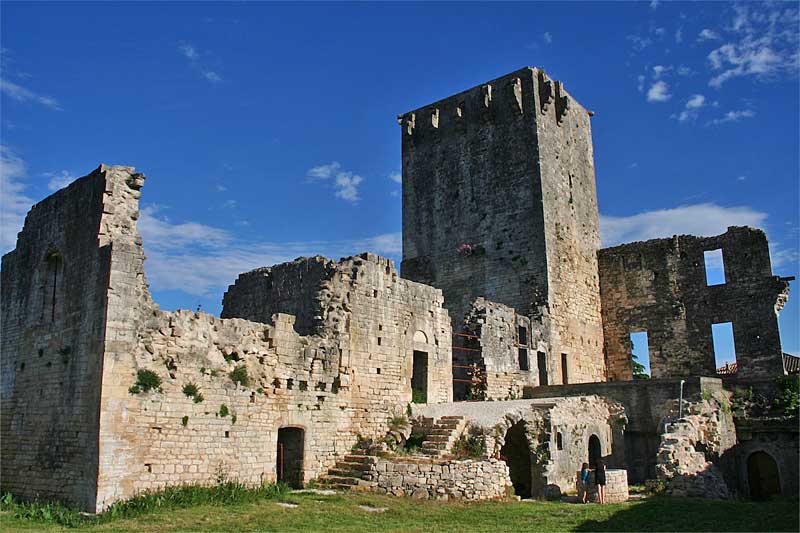
On the borders of the Ardèche but well in the Gard, Montclus was born before the 13th century, in a meander of the Cèze.
Archaeological excavations, near Montclus, have shown that man has been present in Montclus since time immemorial, as proven by the discovery of a stratification dating from 8000 to 2000 BC...
Its position on a hill surrounded by mountains earned it its name, "Castrum Montecluso", mentioned in its Latin form in a document of 1275.
Surrounded by vineyards and lavender fields, this small village, superbly restored, offers the visitor the charm of its narrow streets, its white stone houses with high facades, its vaulted passages, its staircases and its luxuriant vegetation.
Its exceptional character, the absence of any modern construction, and its true atmosphere of a timeless village have earned it a place among the "Most Beautiful Villages of France".
A bit of history....
In 1263, an abbey named Mons Serratus was founded in Montclus. The remains of an ancient Benedictine troglodytic monastery, a vast room dug into the rock, remain at the place called "Les Beaumes" which was later used as a chapel by the Templars (12th and 13th centuries).
In 1275, a castle was built, of which only the square keep of great height remains, which dominates the village, which has also preserved a room of the troglodytic Benedictine monastery built by the Templars downstream near the Cèze.
In the 13th century, the castle and the village belonged to the Counts of Sabran, and were located in the northern part of their territory. Like the counts of Anduze and Barjac, the counts of Sabran were, since the end of the 11th century, part of the "milites majores", the most important supporters of the count of Toulouse.
In addition to their castle of Sabran, these counts owned the castles of Montclus, Tresques, Saint-Victor-la-Coste, certain parts of the castle of Bouquet, and, at times, the castle of Saint-Laurent-des-Arbres.
Their domain was limited to the North-West by that of the Counts of Barjac, who not only owned their own castle of Barjac, but whose family members or vassals ruled over many other castles, for example that of Féreyrolles, near Montclus.
In the 17th century, the castle passed to the Vivet family and in 1750, by marriage, to the Vogüé family, to whom it still belongs today.
Later on, the Mill Bridge was built over the Cèze, which is said to have rolled with gold flakes.
A beautiful heritage...
And first of all the place des Aires, where formerly, one beat the grain.
In the past, this place was located outside the village, and the houses were massed around the castle. It has remained free of buildings to promote the circulation of air within the village.
This place of the Aires had a fountain at the place of the current monument. This fountain has been dismantled and several of its elements are found in various places in the village.
Today it is the real heart of Montclus and the place where its various events are held, the summer market, the votive festival and of course the famous games of petanque ...!
Another place to visit is the church of Montclus, built in 1825 and entirely restored in 1996.
Also worth seeing is a very pretty little square in the rue du Couvent, enhanced by a beautiful typically Mediterranean vegetation of boxwood, bignone, hackberry, Virginia creeper and oleanders that grow on the facades! Not forgetting the semi-circular fountain which dates from the 19th century.
The old hospital was a dependency of the hospital of Pont Saint-Esprit which had chosen Montclus for its strategic position in the heart of the Cèze valley, between the communes of Barjac and Goudargues. A privileged stopover for travelers, it played a major role during the plague and cholera epidemics of the 19th century.
In addition to a splendid private garden, Monclus is worth the detour for its rue de l'Echoppe, which owes its name to the house located at the entrance of the street, called "La Maison du Barbier" (the barber's house) because one can see a beard plate above the entrance door.
Another street to take is rue Souleiado - the sunny street in Provencal - which goes down towards the Cèze.
It is, along with the Porte de l'Arceau, the second access to the river, and in the past women would cross this arch to fetch water from the Cèze.
The rue de l'Arceau is one of the accesses to the village, starting from the Cèze bridge. In the Middle Ages, it was the traditional way to enter the castle. The alley was busy throughout the day.
The vaulted passage crossed the ramparts from one side to the other and the washerwomen used to wash their clothes at the bridge. The proximity of the river explains the absence of a washhouse in the village, quite rare in a typical southern village.
We can't forget the Mill BridgeNowadays, the river is the perfect place to stop for refreshments. Families gather there as soon as the weather is fine and the light flow of the Cèze in summer makes it a popular place for tourists.
This bridge, the Moulin bridge, built in 1870, which allows to cross the Cèze. It is the first passage to go from one bank to the other from the town of Barjac, further north. It is a bridge without a parapet allowing the structure to resist to exceptional floods, the water going straight over...
Town hall of Montclus
Rue Neuve
30630 Montclus
Tel : 04 66 82 25 73
http://www.village-montclus.fr/
Translated with www.DeepL.com/Translator
(free version)




